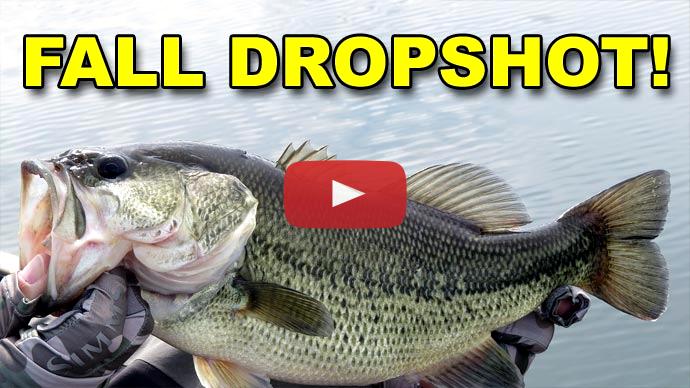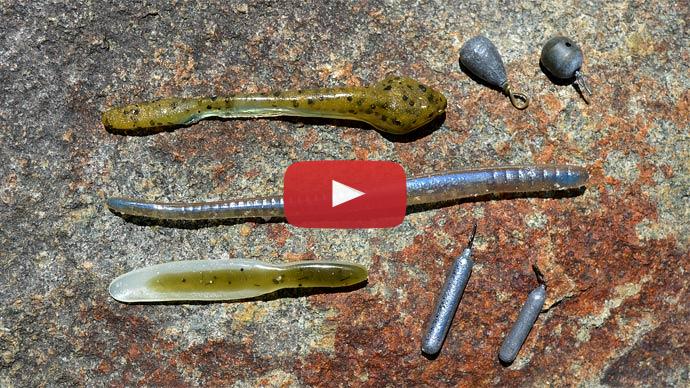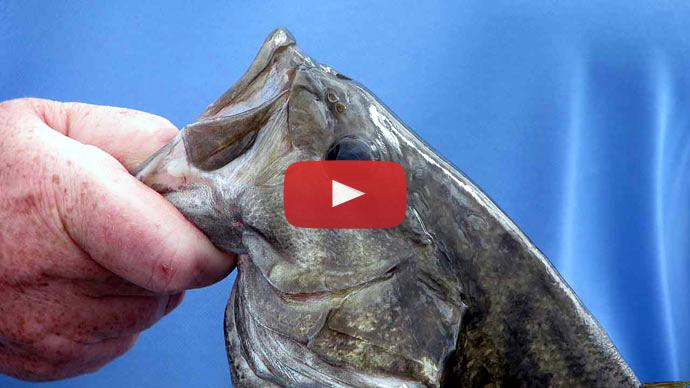Come here. All right.
Keri: He is not happy.
Glenn: Here we go.
Keri: What are you using, Glenn?
Glenn: Drop shot finesse worm.
Hey, folks. Glenn May here with BassResource.com. And today, let's talk about drop shotting. What we're using is spinning gear, spinning outfit for many, many reasons. It starts off with the hook. Drop shot, you're typically using just a size 1 or 1/0 hook. This is a 1. This is a spin shot hook. Looks like that. It spins. If I can get it to spin, see that? And it doesn't spin the line. It twists. It doesn't twist the line. And I have a spin shot for two reasons. Number one, eliminates twist.
The other reason is that it allows the bait to move freely. And I can't stress this enough. With drop shotting, you need that bait to move as natural as possible. This is why I'm using the finesse hand-poured lure. It just wiggles and moves naturally in the water. It's very flexible and flimsy. See that? That's what you want because you need a very natural, natural presentation.
So with a small hook like that, a size 1 or 1/0 hook, it's a thin wire hook. By that nature, it means that you cannot put a ton of pressure on it, otherwise, you'll bend it out and you can lose a fish during a fight that way. It'll just work itself open and the fish'll break free. Or those thin hooks, because it's a 1 or 1/0 hook, it doesn't have a big bite to it and you can literally rip the hook out of the fish's mouth if you're using stout gear or heavy line or your equipment isn't matched properly. You could end up losing a lot of fish that way. And that's part of the frustration a lot of people have with the drop shot is they lose a lot of fish in this because, you know, they wanna blame the hook or something like that. It's because they don't have matched equipment. So let's talk about that a little bit.
Because we're using these small hooks the first thing you wanna do is use a light line. I'm using 6.2-pound Seaguar Fluorocarbon Finesse line. Yup, 6.2-pound. That's weird. Why 6.2-pounds?
Well, couple things. First of all, Seaguar, they invented fluorocarbon fishing line. And because of that, they create their own resin that's made specifically for fluorocarbon fishing line. They are in control of that. They don't buy it from a third party like other line manufacturers do. They make their own. They manufacture their own lines. So they are 100% in control of quality control the whole way. Because of that, they can make any pound they want.
In this case, 6.2-pound is what I like because it offers that real flexibility, allows the bait to move naturally in the water. It's not stiff. It allows it to bend and flex. It's got super sensitivity to it, which you need because the bite is gonna be subtle. So any kind of sensitivity that you can glean and put it in your favor, that's what you need, and that's what fluorocarbon does.
Fluorocarbon also is heavy. So it doesn't have any buoyancy to it. So it is neutral. As far as the bait's concerned, it's not gonna impede the action of that bait. Whereas braid, on the other hand, braid's buoyant. You're gonna get a bow on the line, it's gonna impede the action of that bait because it pulls back on it. It doesn't allow it to flow freely. Plus it's no stretch whatsoever. And on a light wire hook, that's exactly the opposite of what you want. You want a little stretch and give when you're fighting the fish so you don't bend that hook out. And braid will do that. I don't care if you're using a six-pound braid or not. It doesn't stretch. And that's a characteristic you don't want when you're using light hooks.
So I don't even use braid at all. Like, I don't have, like, a leader on it or anything like that because it defeats the purpose of using the fluorocarbon. I use some backing on here with braid, so I don't have to use all fluorocarbon because that's expensive. So I'll maybe use 60, 80 yards of fluorocarbon line with braid backing. But I'm not using, like, braid line with a leader, if that makes any sense. Because I want to use the advantages that fluorocarbon has for finesse fishing. So that's why I'm using 6.2-pound line.
Any heavier line, and it starts to impede the action of the bait. Seven-pound, 8-pound, 10-pound, it's just a little too wirey and the bait doesn't get to flow as freely as it should. So a six-pound line works really well for drop shot.
The rod itself is a medium-light powered, moderate action rod. Lots of bend and flex to it. I don't know if you can see that or not. I can bring this down a little bit, but, boy, it's got a lot of flex to it. That's what you want. It acts kind of like a spring. It kinda gives, when that fish surges, when you're fighting them back to the boat, it gives. It doesn't pull back on the fish, which is, again, can cause a problem with the hook. So you need that real light action. It's gonna work in concert with that line when that fish takes off and runs, it's gonna give a little bit, let that fish go. And that's why I'm using spinning gear here.
Spinning gears, the drag is this way. The discs are over here. So they're bigger discs and that way, they have greater surface area. So by nature, they have a smoother drag. And that's what you want or something like this, a nice smooth drag. When that fish makes that run, you want a nice, steady, slow pull. You don't want to go because that's just gonna work the hook loose when the fish is fighting. So a good, strong, steady drag is what you need for this type of deal, for drop shot fishing.
And then here I just got a teardrop-shaped drop shot weight. It's on a little swivel so it doesn't get snagged as much. Doesn't have to be a swivel, but I like to have a little swivel on it. This teardrop shape, now if I'm fishing in areas that have a little more rock in it, fishing deeper structure that's a little more chunky rock, then I might go to a straight cylinder shape drop shot because it doesn't get hung up as much in the rocks.
But I will not fish rip rap. I'm gonna save you guys a lot of frustration right now. Don't fish drop shot and rip rap. You're just gonna get frustrated because about every other cast you're gonna get stuck and you're probably gonna lose a lot of drop shot weights. So just don't do it. Don't fish rip rap, you know, chunk rock, that kind of stuff with drop shot. Other than that, it works very well in a lot of different areas.
I hope that helps. For more tips and tricks like this, visit BassResource.com.



